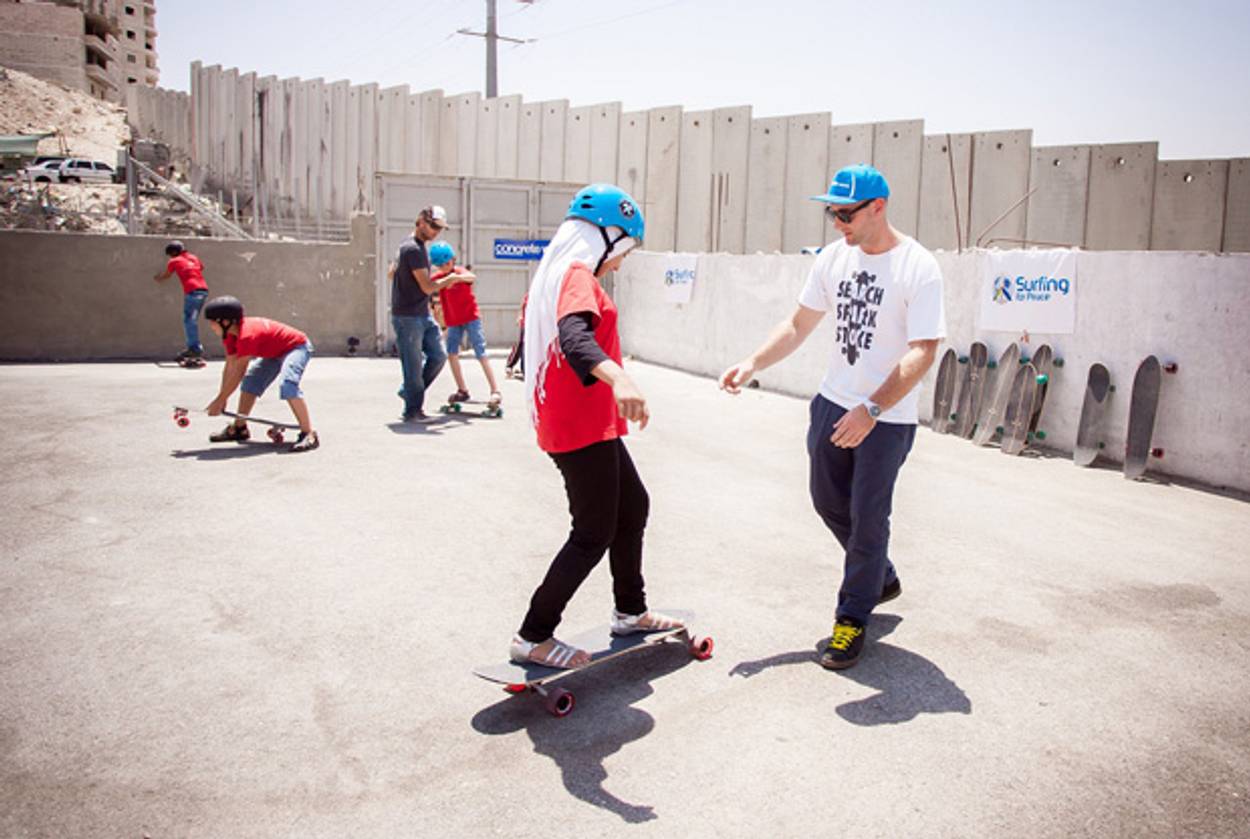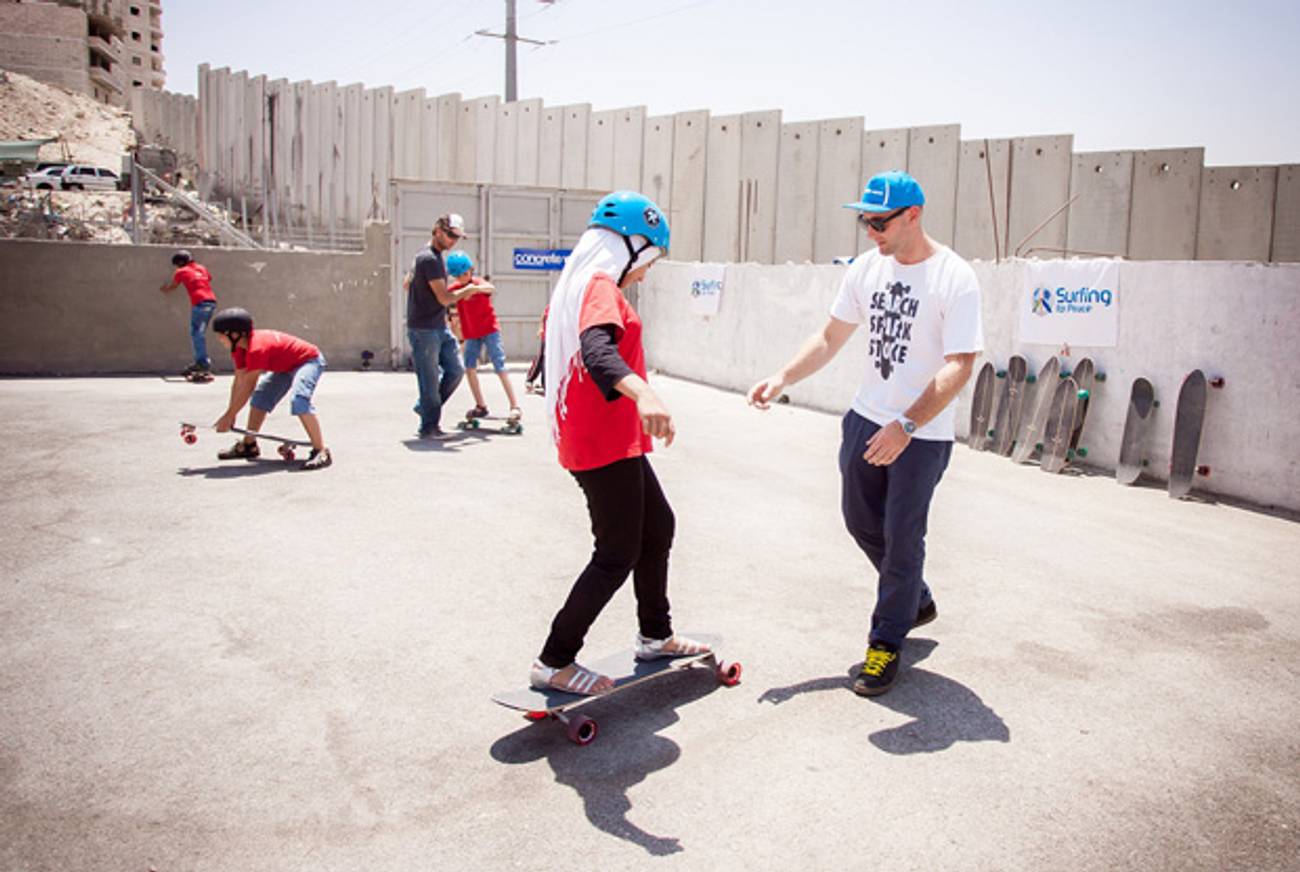Skateboarder Without Borders
Teaching Israelis and Palestinians to ride longboards, I saw the power of the sport to bring kids together




Ever since I first got on a longboard—a longer version of a typical skateboard—in 1976, I was hooked. I had been skateboarding for a year by then, but I loved the way the longboard’s soft wheels glided over cracks and turned so effortlessly it felt like I was surfing on concrete waves. Boarding, I was sure, was the great love of my life.
Then, in the spring of 1988, when I was 23, I met my wife. Born in Tel Aviv, she had just moved to Toronto, where her father had relocated for work. Though I wasn’t looking to get married, we wound up at a dinner party together and things mushroomed from there. We were married the following January and traveled to Israel together that summer.
A second trip never came. We had always wanted to take our children, now ages 11, 12, 16, and 18, back for a visit, but, as they say, life kept getting in the way. I got back into longboarding seriously in 1995 and in 2002 started Concrete Wave, a magazine devoted to the sport. Finally, in shul last fall, our rabbi encouraged the congregation to support Israel by vacationing there. My wife turned to me and whispered, “We have to get back.” I nodded my head in agreement, and this July—23 years since our first trip—we returned with our four kids for a month.
I was determined to have the trip be more substantive than the typical 10-day whirlwind tour. My wife has strong roots in Israel, and we wanted to make the experience as enriching as possible.
Inspired by Skateistan, a phenomenal organization that uses skateboarding to empower kids in Afghanistan, I wanted to give young people in Israel and the Palestinian territories a similar opportunity. I already knew that longboarding can put a smile on any child’s face and thought that getting kids to ride with people they don’t normally interact with might start to build positive relationships from the ground up—literally.
I reached out to an organization called Surfing 4 Peace, which coordinates surfing events in the Middle East with the goal of bridging cultural and political barriers between surfers. They set me up with the Jaffa-based Peres Center for Peace, an organization they work closely with in Israel. The Peres Center began scheduling longboarding demos across Israel, and I started planning. Getting the supplies donated was easy. The stressful part, it turned out, was ensuring that the longboards and helmets were delivered from the Unites States on time. The equipment arrived in Tel Aviv right before the first demo, on July 5.
There were 15 local Arab kids from Jaffa who showed up at the Peres Center, and they were soon rolling around on the longboards. Another 15 Israeli kids from a Tel Aviv martial-arts club joined in. After a few minutes, the groups began to cooperate, and their enthusiasm was overwhelming.
“Please, tell me,” a young Arab boy asked, “how much … how much?” He wanted to buy a longboard then and there. “When is the next event?” another boy screamed with delight, as others begged the staff for more time. Mickey Kook, a Surfing 4 Peace volunteer who attended the demo, told me the experience had been transformative for him. “It’s so easy to get caught up in what the media chooses to show us, and reality always has a way of surprising us,” he said.
Next stop was Sderot, an Israeli city near the Gaza Strip where 10,000 rockets have fallen since Israel pulled out of the strip in 2005. Before the demo started, a volunteer located our closest bomb shelter. Sderot had been bombed just the week before. But here we were in the skate park, and so were the kids.
One young boy from an impoverished family wouldn’t let go of the board after the demo. But it was another boy, practically mute and cloaked in an air of sadness—whose parents, I later learned, are coping with drug addiction—who left the biggest impression on me. He got on the board and started rolling around the park, and I watched as his demeanor visibly lightened. Maybe it’s the sense of freedom, or the weightless feeling of gliding, but there is magic in the rolling board.
Jaffa and Sderot had been successes, but I was nervous about the next few demos, in East Jerusalem and Jericho. Friends back home in Canada had warned me not to go to either of these places upon hearing of my plans, fearing for my safety. One friend asked if I was going into Jericho with soldiers from the Israeli Army, and I told him no; I was going in with longboards.
Our staff assembled at 8 a.m. to start our journey to the Shuafat Refugee Camp in East Jerusalem, where we were hosting a demo at a school. We were a pretty diverse group—six Israelis, two Canadians, one American, and a Brazilian—though for most of us, this was uncharted territory. Yoni Ettinger, an Israeli and a professional skateboarder, summed it up: “You made me feel like a tourist in my country,” he told me.
This demo was different and perhaps the most moving for me to watch. While we had younger children, ages 7 through 12, at the Jaffa demo, this was the first time I had seen teenagers and young adults joining in. While the boys took to the longboards as quickly I had come to expect, Palestinian young women, at least a dozen wearing hijab, hopped on boards alongside them. “I was nervous about going to the Palestinian territories,” Yoni told me after the demo. “I figured I was going to look like an alien to these people. But what I quickly discovered was that we had a bond, and that bond was longboarding.”
Next, we headed to Jericho for a boarding demonstration with 25 kids, amped up from a soccer practice in the sports-oriented city. Unfazed by the more-than-100-degree heat, they were eager to participate, taking to longboarding more quickly than any of the previous groups had. I was blown away by the grace with which these kids maneuvered on boards they had never ridden before. The group sped around, Israelis, Arabs, and North Americans among them.
My oldest son, Jonathan, joined me at all four demos. I could sense that the experience had left a deep impression on him. “I didn’t know what to expect with these demos,” he told me. “I definitely want to come back and do more.”
After the demo, we brought the kids together to discuss what had happened. I shared how impressed I was with their collective longboarding prowess, and once the interpreter explained what I was saying, their faces lit up and they applauded themselves. Here, just as everywhere we went, all the kids wanted to know was when we’d be back for the next session. We’re heading back to Israel in the fall, where we have a full eight months of workshops planned for Jaffa and more demos scheduled in Beit Shemesh.
***
Like this article? Sign up for our Daily Digest to get Tablet Magazine’s new content in your inbox each morning.
Michael Brooke is the editor and publisher of Concrete Wave and the founder of Longboarding for Peace.
Michael Brooke is the editor and publisher of Concrete Wave and the founder of Longboarding for Peace.